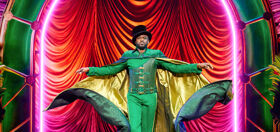View this post on Instagram
The following is an excerpt from Did You Sleep With the Models? by Sam Staggs, former editor of the gay magazines Mandate, Honcho, and Playguy. Read the book free at samstaggs.substack.com
Chapter 1: Thank You For Dropping Dead
From my first day in New York I looked for a job in publishing. Eventually I landed one — almost by accident — that many a gay man envied. I became editor-in-chief of Mandate, Honcho, and Playguy. These magazines, highly regarded by thousands of gays, were looked on by others as NOKD–“not our kind, dear.” After two turbulent months of screwball hijinks in what I came to view as a corporation of nuts, it looked as if I’d survive.
Then it happened. I was working late one dreary, freezing night in February when, just after eight o’clock, the stranger rapped on the door. When I saw his face, I froze. This man was the opposite of the muscular, sexy model who should be standing there.
Cross-eyed fate had played me a dangerous, nasty trick.
I was alone, the only person still at work on that vast, silent eleventh floor at 155 Sixth Avenue, on the fringe of SoHo. My colleagues had left hours ago. The place was beginning to chill as heat lowered for the night. Blackish snow lingered on pavements, unsightly slush dribbled in the streets before refreezing in the night cold. The city lay under a dingy pall. Outside, New York noise was muffled, and in the depths of this shadowy eleventh floor, deep silence held dominion.
How about we take this to the next level?
Our newsletter is like a refreshing cocktail (or mocktail) of LGBTQ+ entertainment and pop culture, served up with a side of eye-candy.
I finished the feature I was editing, reread several letters to the editor and decided on the ones I would run next issue. I looked at the wall clock. Where was my visitor? His appointment was for eight. That morning he had called and said, in a pleasant, professional, masculine voice, “I hear you’re the new editor. I’d like to show you my portfolio.” A pause. “You might be able to use me as a model in Mandate. Possibly Honcho.”
“Thank you for calling. Yes, of course I’d like to see your pictures. Can you drop them in the mail, or leave them with the receptionist?”
“Well… I could.” Another pause. “Don’t you want to see me in person?”
“I’m sorry, I’m quite busy but if you’ll send a few pictures…”
“I’d rather not send them that way,” he said, a smile in his voice. “I’ll only take a minute of your time if you let me drop them off in person.” He followed with a flattering description of himself and his attributes.
“You’re persuasive,” I laughed. “Okay, I’m convinced. But you’ll have to come at the end of the day. I work late. Around 7:30?”
“I’ll see you at eight. If that’s, ah, not too late.”
I imagined him as the new star attraction. The hunk du jour. Du jour, hell; Mandate’s Hunk of the Year. A big photo spread, possibly a cover, for the first or second issue with my name on the masthead. A star indeed, from the sound of his voice. My imagination leapfrogged.
“We’re on the eleventh floor. Knock loud or I might not hear you. I’ll be the only one working.”
Editors and art directors usually charged out the door at six on the dot. Others — for instance Karen, who operated the early-eighties computer, or Josie, who handled payroll — sometimes stayed later. Then they popped into my office to say goodnight. Our publisher, a contemporary Scrooge, turned off so many lights as he walked out that I once considered parading down the corridor with a white cane to shame him.
Finally, my eight o’clock appointment knocked. Late, but maybe the subway stalled between stations. A frequent occurrence.
The hallway, scooped in low-light chiaroscuro, mimicked a Fritz Lang film noir as I walked down the corridor to the entrance, directly in front of the elevators. The top half of the door was made of crinkly glass, so I could make out only a dark form. Not as tall as I expected. I opened the door and —
If I had seen my expression it would have shocked me. Or did I freeze it in mask-like composure? Something was terribly wrong. The visitor hurried in.
A troll from a wanted poster in a post office. Hannibal Lecter crossed with Quasimodo. Well along in middle age, flaky skin and patchy hair, dressed in bureaucratic office attire of cheap brown tie with coffee stains, grimey shirt, dark rumpled trousers, tweed sport coat beginning to show its age, and over that a navy overcoat sprinkled with dandruff. Behind thick-lensed eyeglasses, darting eyes like someone being pursued. Perhaps he was. A frozen moment. I had made a grave error.
Whatever I learned in Mr. Austell’s high school drama class served me well that night. That, and quick thinking.
“How do you do, Mr. Jones? I’m Sam Staggs. Please come in.”
He followed me down the hall to my office. I offered a chair, sat down at my desk opposite him, chatted a moment about the weather, asked whether he worked downtown, then, “Well, I’m eager to see your portfolio.” As he handed it to me, I added, “Tell me about your previous model work.” That baritone voice on the telephone had thinned. Whatever he said didn’t register. Too many scenarios spinning in my head.
Remember Jack Nicholson in The Shining? The scene where his wife, played by Shelley Duval, looks at his typewriter, then opens his manuscript box and picks up the “novel” he’s been working on for ages, only to find hundreds of pages with the typed line, “All work and no play makes Jack a dull boy, All work and no play makes Jack a dull boy,” ad infinitum.
That was me, and here was Jack.
But on the phone he sounded so — or did he? Obviously, I hadn’t paid close attention, I was busy and didn’t ask enough questions, I should have insisted on a four p.m. appointment at the latest. Too late now for coulda, shoulda.
In the three-ring binder he pulled from his briefcase were dozens of clear plastic archival storage pages for 35mm slides. Each slot contained a color slide, and every one was him in the same frightful pose: hunched forward in that infinity of slides, decked out in yellowing shirt, coffee-stained brown tie, aging jacket, and eyeglasses. Fortunately, no nudes.
“These are interesting,” I said, wishing my heart would slow down. “When were they taken? You must have the photographer get in touch. Here’s my card.” My life could depend on this performance. Not too enthusiastic. He surely knows at some level how unlike a model he is. Nuance: just enough encouragement, not too much cordiality. Keep the tone steady. This is how you talk to someone perched on a ledge. Fifty stories up — or eleven, like me.
He sat impassive. What does he want from me?
“Well?” he said, staring.
“Can you leave several slides for my publisher to look at? I’m sure you realize that we have many photos on hand. We schedule our issues months ahead.” I pictured him naked, back to camera, head turned provocatively over right shoulder in a Betty Grable pose — with a hairy back and saddlebag love handles.
He frowned. “How do you like them?”
I imagined next day’s front-page headline in the Post:
SKIN MAG WANNABE TOOK AN AX
Gave the Editor 40 Whax
“I can’t choose models without my publisher’s okay,” I lied. “I appreciate your coming in. I hope I haven’t taken too much of your time.”
But he smelled a rat. “Why don’t you like them?” he demanded.
“It’s not that. But so much material. Look at that stack over there — ”
“I intend to pursue this,” he snarled. “You watch. I’ll get to the bottom of it!”
“I’m sorry you’re disappointed, Mr. Jones. If you’d like to take it up with Mr. Mavety, the publisher, I’ll be happy to make an appointment.” Would Meryl Streep have applauded my performance? Would Stanislavski? How about Barbara Stanwyck, strangled at the end of Sorry, Wrong Number?
He stood up, jabbed his right hand into his pants pocket. A gun? He was not glad to see me.
I stiffened.
He snatched his slide portfolio, slammed it into his battered briefcase, and headed for the door.
“I could kill you for this,” he muttered.
The climax of the drama. Fight or flight. Him or me. Surging adrenalin brought me to my feet, fists at the ready.
“Do you think I don’t have protection in a place like this? Alarm button under my desk. Night security’s on the way.”
Night security didn’t exist.
I walked a few steps behind, ready to pound, kick, go for the jugular.
He jerked open the door, rushed into the hallway, ran past the elevators, spotted the red EXIT sign, and dived down the stairs.
“Thank you for dropping by,” I murmured in a shaky voice that no one heard.
Thank you for dropping dead.
So Agatha Christie might have ended the scene, as Mr. Jones, the ax murderer, wiped his instrument on his coffee-stained tie, picked up the latest issue of Mandate, held it up beside his face, gazed into a mirror, grinned, and said, “Ready for my close up!”
Seated at my desk, breathing slowed, I said aloud, “How stupid are you? You could be spouting blood right now.”
The thought occurred later that I probably could have pinned him to the floor. He was no strongman. But what if it was a gun in his pocket… or a switchblade… a blunt instrument under that dandruff-sprinkled overcoat?
Across these many years, I wonder: Was he a homicidal maniac, fresh from an after-dinner murder, or merely a poor delusional drone stuck in some Kafkaesque office? Or perhaps a lonely man who lived at home in Queens or on Staten Island with his mother… just like Tony Perkins.
The next day, hearing the story, my associate editor mimed a shower-stabbing as he crooned in a Norman Bates voice, “You might fool me, but you won’t fool my mother!” After that, when I worked late I made sure the door was locked and extra lights left on. And no appointment that could mimic a Hitchcock script.
That chilling incident, even in the rear view mirror, still sends a frisson. Right now I’ve got goosebumps on my arm.
I heard from him once more–or maybe not. The voice was similar. Back then, I was still listed in the Manhattan phone book. One evening in March I came home to my apartment, turned on the lights, and noticed the red notification button on my answerphone.
“You’ve been f*cking my boyfriend, and I’m going to kill you.”
Safe at home on the third floor at 270 West 91st Street, I erased the message. I could have used a cigarette, but I stopped smoking when I was twenty. I said aloud, as if at the end of a precode Warner Bros. melodrama ca. 1932, “Oh yeah? Which one was yours?”
Sam Staggs is the author of eight books, including All About “All About Eve”: The Complete Behind-the-Scenes Story of the Bitchiest Film Ever Made (2000); Close-up on “Sunset Boulevard” (2002); When Blanche Met Brando: The Scandalous Story of “A Streetcar Named Desire” (2005); Born to Be Hurt: The Untold Story of “Imitation of Life” (2009); and Inventing Elsa Maxwell: How an Irrepressible Nobody Conquered High Society, Hollywood, the Press, and the World (2012), all published by St. Martin’s and all in print.
His latest book, Finding Zsa Zsa: The Gabors Behind the Legend, was published in 2019 by Kensington Books. (Audio version read by the actor Paul Boehmer for Blackstone Audio.) This biography has been optioned by Amy Sherman-Palladino, writer/producer/director of “The Marvelous Mrs. Maisel”, for a film or miniseries. (Blackstone has recently brought out All About “All About Eve” and Close-up on “Sunset Boulevard” on audio.)
Staggs’s work has appeared in a number of anthologies, including The Best American Movie Writing 2001 and Vanity Fair’s Tales of Hollywood (2009). His earlier journalism appeared in Architectural Digest, Vanity Fair, Opera News, Publishers Weekly, New York, Artnews, and a number of travel magazines.



















bradford44444
This is so poorly written, I could not make it past the third paragraph. Why do I ever visit this site?
jettrink87
I found it gripping. The suspense built up as the tale wound to a fortunate conclusion (whew!). NYC in the ’80s could be a singularly scary city, with an undiscovered serial killer on the loose. I will definitely check out more of his book at Substack!
Mack
Yeah why do you come in here, all you do is bitch.
PVTom6670
Not sure what b-44444 read, but it was NOT poorly written. “Did You Sleep With the Models?” is titillating, entertaining, and well written. Sam Staggs has a follower. I’ll be reading more of this book.
storm45701
Dude, no idea what you’re reading, but it’s actually very well-written.
PinkoOfTheGange
Because being a troll is the only way you can get attention.
Cam
Because how else would you be able to keep switching screenames and always attack out of the closet celebs and the site?
bachy
Personally I found the account quite chilling.
Mack
I agree. Start of a good novel.
Vince
I’ve been there at times myself.
morgan
Bradford44444 must be that rejected model from Chapter One — and still crazy after all these years.
Well just let me say
Click bait – doesn’t answer the headline – did you sleep with the models!
morgan
I believe this is his first chapter…you have to read further to get to the meat of things. Try it.
PinkoOfTheGange
You honestly don’t know difference between an interview (that should answer a question) and an excerpt from a book who’s title is in the headline?
Kangol2
What a story. I could picture the creep who showed up with his “portfolio,” too. That editor is very lucky; New York in those days was a lot wilder and more dangerous, even for a kid or teenager let alone an adult, than it is today!
Beachman
I lived in NYC in the mid 1980’s…..and there were a lot of creeps like he described hanging out in the gay bars. Not many of us survived the 80’s.
Diplomat
I found the writing quite engaging. So much so I think I’ll give the book a read.
mateo
I’ve read a few of Sam’s books on films and have absolutely loved them. I never knew that he’d also been connected to skin mags back in the day. This book sounds like a great read!
Tombear
I loved it and my opinion is the only one that counts. If you don’t believe me ask my mother!
SariState
Not since I last watched “Who Killed Teddy Bear” have I been so delightfully unnerved. Mr. Staggs so perfectly blends mounting suspense with wit (remember wit?) in this finely crafted bit of Grand Guignol, made even more terrifying because it really happened.
barryaksarben
I’ve read a few of his books and really enjoyed the all about eve and sunset Blvd one in particular. when I read the first one I was bothered that I couldn’t place where I had seen his name before and it wasn’t til reading this article that I remembered my quite complete collection of two of these mags. lived in West Hollywood for the early 80s and I did sleep with four or five of the big pornstars of the era. Good times. Thanks for everything Sam
bachy
Unforch it doesn’t appear to be available on Amazon yet.
MSM
At first, i thought maybe he was day dreaming the encounter, and that the visitor was HOT and ready. He would awaken from the scary scenario when the real model wanna-be showed up at his door. But i found Sam’s story to be well written and grabbed me.
Some people havent read anything since Fun With Dick and Jane.
I will get the book.
Cam
Sounds like a scene from American Horror Story. Not a fun night!